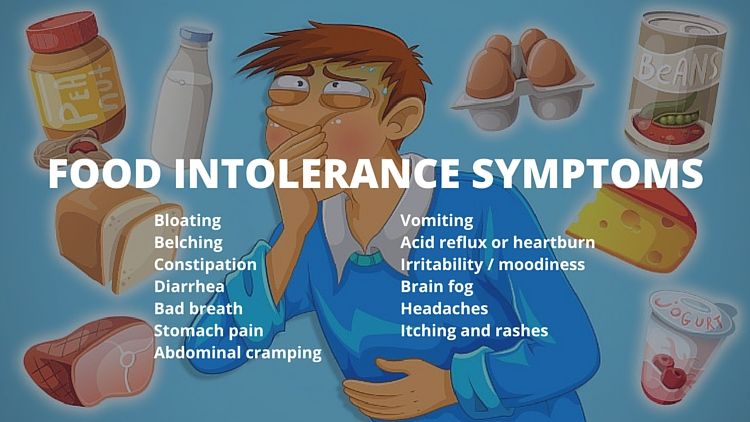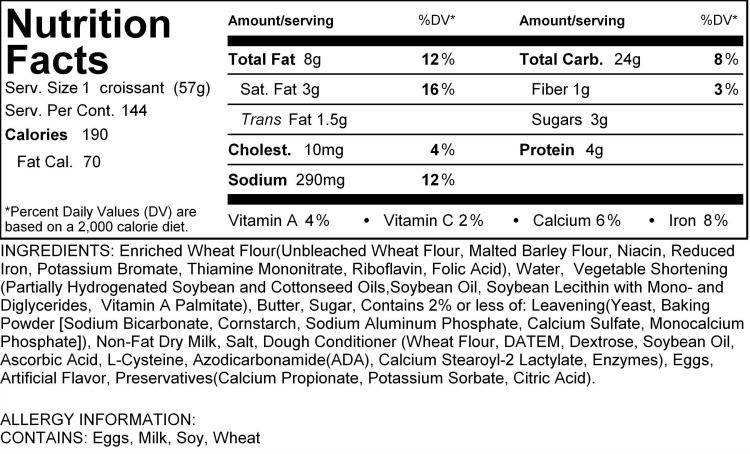In this article
If you feel bloated, fatigued, foggy, moody, and just plain “blah” on a regular basis, you probably know that’s not normal.
And you’re likely looking for some solutions.
But how do you know what to believe? There is a ton of information online about those symptoms – ranging from nutrition tips to supplement advice. How do you sort it all out?
One of the best places to start looking for clues about your symptoms is your diet.
More specifically, to investigate whether you have hidden food intolerances.
Food Allergy vs. Food Intolerance
Perhaps one of the reasons food intolerances are so commonly overlooked is because they aren’t as obvious as food allergies.
In fact, they can be extremely hard to pinpoint.
For clarity’s sake, I’m going to break down three different adverse reactions your body can have to food: food allergies, food sensitivities, and food intolerances.
Food Allergies
Chances are, if you’ve ever had a food allergy you’ve known it – although they have been known to suddenly develop, even in adults.
A true food allergy will cause the body to elicit an immune response by triggering the release of histamine (a substance released by your cells in response to an allergy) and IgE antibodies.
In true food allergies, the body sees a food as dangerous, and can cause life-threatening reactions such as anaphylactic shock (1).
Since food allergies elicit an immune response and trigger the release of specific antibodies, a food allergy can easily be detected on an allergy test administered by your doctor.
Food Sensitivities
Food sensitivities aren’t considered true food allergies because the body doesn’t release histamine, IgE antibodies, or cause a deadly reaction in response to a food.
However, food sensitivities have been shown to release a different kind of antibody – IgG antibodies – which indicate the body still sees the food as a potential threat, but doesn’t elicit such a harsh response.
And although the antibodies for food sensitivities can be detected on tests, you may not realize you have one.
This is because the symptoms of food sensitivities can be almost anything – headaches, brain fog, irritability, and digestive issues. And not only that, these symptoms are often the same as those that occur with other health conditions.
The symptoms of a food sensitivity can have a delayed reaction, and may also not show up until one or two days after the offending food has been ingested.
Nonetheless, since food sensitivities trigger the release of IgG antibodies, they can be detected on IgG food sensitivity tests administered by your natural healthcare practitioner, or naturopathic doctor.
Food Intolerances
Food intolerances are different than both food allergies and sensitivities.
Instead of triggering an immune response or an allergic reaction, food intolerances often produce very quick digestive responses, such as gas or bloating after eating dairy.
Unfortunately, food intolerances are nearly impossible to test for because they don’t stimulate the release of antibodies.
If you are intolerant to a specific food, it simply means your body has issues digesting it. A food intolerance isn’t life-threatening in the way a true food allergy is, but can cause severe digestive discomfort.
And if a food intolerance isn’t taken seriously, it can become a source of inflammation in your gastrointestinal (GI) tract. This can contribute to the onset of chronic digestive issues such as irritable bowel syndrome (IBS).
Intestinal inflammation caused by a food intolerance may also impair your body’s ability to absorb essential vitamins and minerals. This can lead to serious nutrient deficiencies down the road.
One example of a very common food intolerance is dairy. In order to properly digest dairy, our bodies must produce the digestive enzyme, lactase.
Lactase helps us digest the sugar found in dairy called lactose. When we’re babies, our primary source of nutrition is breast milk, so our bodies produce lactase from the moment we’re born until breast feeding stops (usually around ages 3-4) (2).
If you experience symptoms such as abdominal pain after consuming dairy, it’s likely that your body isn’t producing enough lactase to properly digest it.
It is true, however, that not all people are sensitive to dairy. Depending on genetics, some people will continue to produce a sufficient amount of lactase well after breastfeeding ends.
Food intolerances all depend on an individual’s digestive system and current state of health.
Symptoms of Food Intolerances
Most food intolerance symptoms affect the digestive system. The most common food intolerance symptoms are:
- Bloating
- Belching
- Constipation
- Diarrhea
- Bad breath
- Stomach pain
- Abdominal cramping
- Vomiting
- Acid reflux or heartburn
- Irritability / moodiness
- Brain fog
- Headaches
- Itching and rashes
What Causes Food Intolerances?
Several different factors can lead to food intolerances such as:
Additives, preservatives and toxins in food.
Since chemically derived food additives and preservatives aren’t always recognized by the body as “food,” the body can have difficulty digesting them, which creates an intolerance (3).
Some of the most common food intolerances are to additives and preservatives such as MSG, sulfites, aspartame and other artificial sweeteners, and food colors and dyes (such as yellow dye #3, found in many processed foods to give them an orange color) (4).
If you’ve ever felt foggy, irritable, or experienced a headache immediately or a few days after drinking diet soda or eating processed foods (which commonly have MSG or artificial colors added to them), then it’s likely you have a food intolerance to a specific food additive or preservative.
Digestive enzyme deficiencies (and eating too much of a specific food).
When discussing dairy as a food sensitivity, we briefly touched on the importance of specific digestive enzymes to help digest the foods you eat.
Now, this is true not only with dairy, but with hundreds of other foods that your body must produce enzymes for. Without digestive enzymes, your body is unable to break down food into smaller particles for digestion.
We won’t get too scientific here, but if your body is underproducing any type of enzyme, you can experience food intolerances to foods that require the enzyme in question.
In some cases, it can help to take a plant based digestive enzyme supplement – such as bromelain – before each meal to help further assist with the body’s digestive process. Extra enzymes can help prevent the symptoms of food intolerances by improving the overall digestive process.
Digestive enzyme deficiency is a sign of a weakened digestive system (which is often caused by stress) and may also indicate that too much of a specific food is being consumed.
It sounds strange, but in some cases, your body can only handle producing a certain amount of enzymes – not an unlimited amount.
For example, let’s say you’re eating wheat every single day, at every meal. You have toast with breakfast, a sandwich at lunch, and pasta at dinner.
Your body initially may be able to produce a sufficient amount of enzymes to break down the wheat, but eventually, you may stop producing the enzymes because the food is being over consumed (5).
This is why the onset of food intolerances can seem to appear suddenly, when a food you used to enjoy suddenly “bothers” you.
Metabolic conditions.
Metabolic conditions such as type 2 diabetes can interfere with how the body digests and absorbs nutrients, which can lead to food intolerances, specifically to sugar.
On the contrary, food intolerances to carbohydrates can also lead to diabetes – which can make a “chicken-or-the-egg” situation when it comes to discovering which condition occurred first.
In any case, type 2 diabetes is an example of your body becoming intolerant to digesting the sugar from carbohydrates.
When too much sugar is being consumed and your body becomes insulin resistant, it means your cells have temporarily stopped allowing sugar in, because there’s too much of it to deal with.
It’s possible to be intolerant to sugar, and it’s also possible for the sugar intolerance to lead to a more serious metabolic condition, such as diabetes (6).
Gastrointestinal (GI) disorders.
GI disorders such as irritable bowel syndrome (IBS) have also been linked to food sensitivities, which suggest they may also play a role in food intolerances (7).
This is due to the fact that IBS and other digestive disorders can impair the body’s natural ability to digest and absorb nutrients. When certain foods are harder for the body to break down, there’s more of a risk for food intolerances to develop.
The 3 Most Common Food Intolerances
While a food intolerance can occur to virtually any food, there are a few food intolerances more common than others (8).
These foods include:
1. Dairy Products
As previously mentioned, many of us stop producing a sufficient amount of the enzyme, lactase, after the ages of breast-feeding. Lactase is needed to digest lactose, the milk sugar found in dairy.
Dairy intolerances can vary. Most people are sensitive to casein, a type of protein found in dairy products. Others may also be sensitive to whey, another type of protein found in dairy.
Dairy intolerances are also more common now due to the fact that dairy is found in so many foods that we eat. While an enzyme deficiency may be the reason you’re intolerant to dairy, constant exposure to dairy (which is found in the majority of processed foods) can also cause the body to stop properly digesting it.
2. Wheat and Gluten
Gluten is the protein found in wheat, which the body can have difficulty digesting (9).
Gluten is also a common food intolerance because it’s something we’re exposed to in many different foods, such as bread, cereal, pasta and the majority of processed foods.
[Related: Wheat-Free Diet: A 5-Step Detox Plan to Lose Your Belly]
3. Soybeans
Soy is another food intolerance that has become much more common today.
Like gluten, soy can be hard for the body to digest, and is found in the majority of processed foods. Most of the world’s soybeans are now genetically modified (GMO), which could be part of the reason why more people are developing intolerances to soy.
This is likely due to the type of pesticides that are used on GMO soy crops, in addition to how soy is being processed (10).
Other food intolerances that are on the rise include eggs, shellfish, tree nuts, and peanuts (11).
How to Test for a Food Intolerance
While medical doctors and naturopathic doctors can test for food allergies and sensitivities, testing for a food intolerance can be tricky.
Since the body doesn’t typically produce an immune response in a food intolerance, one of the most common ways to test for a food intolerance is by doing an elimination diet.
A food intolerance elimination diet aims to pinpoint food intolerances by removing the suspected offending foods from the diet for roughly two weeks at a time. An elimination diet is best done under the supervision and with the guidance of a healthcare practitioner.
If you suspect you have several food intolerances, many foods may be eliminated from your diet at once. If your symptoms subside during this time, it’s then recommended to reintroduce the offending foods back into your diet, one at a time (14).
At the point of reintroducing foods into your diet, you’ll know you have a food intolerance if a certain food triggers symptoms after being reintroduced.
It’s also important to monitor your symptoms in a two-day window, since intolerances can often be delayed. For example, if you remove dairy for two weeks, and then experience a headache or constipation within two days of reintroducing it, it’s likely that you have a food intolerance to dairy.
By reintroducing the suspected offending foods one at a time, you’ll be able to pinpoint which foods trigger symptoms and are best to be avoided.
Now, that’s not to say you’ll have the same food intolerances forever. It can be hard to say how long a food intolerance will last.
Sometimes your body simply needs a break from a certain food, and may be able to tolerate it in the future. You can always reintroduce a food after avoiding it for an extended period of time and monitor how your body reacts.
Treating and Managing Food Intolerances
Although it can be upsetting if your body is saying no to ice cream, as I mentioned, food intolerances aren’t necessarily forever. And luckily, there are many different ways to treat and manage food intolerances naturally.
Here are a few tips for treating and managing food intolerances:
Read Food Labels
To avoid unwelcome reactions to certain foods, always be sure to read labels and check for common allergens such as dairy, wheat/gluten and additives and preservatives.
If you’re eating out at a restaurant, don’t be afraid to ask questions about the ingredients in the dishes and let your server know you have a food intolerance to any ingredients you’re trying to avoid.
Don’t worry: Since food intolerances are so common today, most restaurants will have an allergen guide, or even list items on their menus that are gluten-free, dairy-free, and vegan friendly.
Keep a Food and Symptom Journal
Since food intolerances can sneak up on you days after eating the offending food, it can be helpful to keep a food and symptom journal.
It can be fascinating to see the correlation between symptoms and specific foods when documented on paper, and will also be much easier for you to pinpoint (rather than trying to remember what you had to eat the past week when you’re constipated two days later).
Support Your Gut Health With Fermented Foods and Probiotics
[Related: 17 Recipes Full of Probiotic-Rich Foods You Need to Start Making]
Since food intolerances are a digestive disorder, working on improving your gut health through gut-friendly foods (such as probiotic supplements, sauerkraut and kimchi) can help heal your digestive system, and may also eliminate food intolerances over time.
Take a Digestive Enzyme

Based on your symptoms, you may require a specific type of digestive enzyme. Speaking with a qualified natural healthcare practitioner can help further determine what enzymes are best for you to supplement to manage your food intolerances.
Consider Following a Food Intolerance Management Plan
There are many food intolerance management plans that support the health of the digestive system and work towards healing the gut through diet, by eliminating specific foods.
A common food intolerance management plan is the low FODMAP diet, which eliminates specific types of carbohydrates that are known to irritate the gut and contribute to food intolerances.
Watch for the Signs
Determining whether you have food intolerances and managing your symptoms can be a simple process once you know which signs to look for.
Food intolerances can also help you become more in tune with your body over time, and allow you to recognize an offending food more quickly.
Once you discover what food intolerances you’re experiencing, you’ll be able to take control of your health and feel energized, clear and vibrant again.










